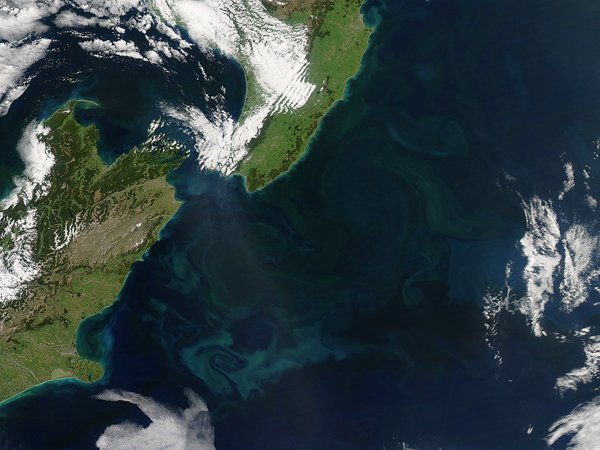Images
November 16, 2015 - Phytoplankton bloom off New Zealand
Tweet
Swirls of peacock and green off the eastern shores of New Zealand mark a massive bloom of phytoplankton in the South Pacific Ocean. The Moderate Resolution Imaging Spectroradiometer (MODIS) aboard NASAís Aqua satellite captured this true-color image on November 2, 2015.
Just off of the east coast of New Zealandís north and south islands, two different currents of water mix. The cold Circumpolar Current flows northward past South Island, while warmer waters flow southwards past North Island. Where they meet, the water currents become turbulent while temperatures and nutrient levels become ideal for the growth of phytoplankton. Since phytoplankton are plant-like organisms that photosynthesize, they are sensitive to light conditions. These light conditions normally become ideal in the springtime and this triggers rapid growth of phytoplankton.
Phytoplankton use chlorophyll and other pigments to absorb sunlight for photosynthesis. When they grow in large numbers, they can change the way the ocean surface reflects sunlight. Also, different species of phytoplankton have different pigments, so the coloration of their blooms are different. As the phytoplankton are caught up in ocean swirls and eddies, patterns and colors are created that can easily be seen from space.
Image Facts
Satellite:
Aqua
Date Acquired: 111/2/2015
Resolutions:
1km (107.5 KB), 500m (361.6 KB), 250m (891.1 KB)
Bands Used: 1,4,3
Image Credit:
Jeff Schmaltz, MODIS Land Rapid Response Team, NASA GSFC
Tweet
Swirls of peacock and green off the eastern shores of New Zealand mark a massive bloom of phytoplankton in the South Pacific Ocean. The Moderate Resolution Imaging Spectroradiometer (MODIS) aboard NASAís Aqua satellite captured this true-color image on November 2, 2015.
Just off of the east coast of New Zealandís north and south islands, two different currents of water mix. The cold Circumpolar Current flows northward past South Island, while warmer waters flow southwards past North Island. Where they meet, the water currents become turbulent while temperatures and nutrient levels become ideal for the growth of phytoplankton. Since phytoplankton are plant-like organisms that photosynthesize, they are sensitive to light conditions. These light conditions normally become ideal in the springtime and this triggers rapid growth of phytoplankton.
Phytoplankton use chlorophyll and other pigments to absorb sunlight for photosynthesis. When they grow in large numbers, they can change the way the ocean surface reflects sunlight. Also, different species of phytoplankton have different pigments, so the coloration of their blooms are different. As the phytoplankton are caught up in ocean swirls and eddies, patterns and colors are created that can easily be seen from space.
Image Facts
Satellite:
Aqua
Date Acquired: 111/2/2015
Resolutions:
1km (107.5 KB), 500m (361.6 KB), 250m (891.1 KB)
Bands Used: 1,4,3
Image Credit:
Jeff Schmaltz, MODIS Land Rapid Response Team, NASA GSFC




